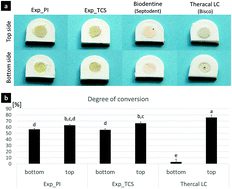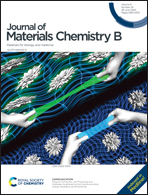Development of self-adhesive pulp-capping agents containing a novel hydrophilic and highly polymerizable acrylamide monomer
Abstract
Several studies have shown the clinical success of hydraulic calcium-silicate cements (hCSCs) for direct and indirect pulp capping and root repair. However, hCSCs have various drawbacks, including long setting time, poor mechanical properties, low bond strength to dentin, and relatively poor handling characteristics. To overcome these limitations, a light-curable, resin-based hCSC (Theracal LC, Bisco) was commercially introduced; however, it did not exhibit much improvement in bond strength. We developed a light-curable self-adhesive pulp-capping material that contains the novel acrylamide monomer N,N′-{[(2-acrylamido-2-[(3-acrylamidopropoxy)methyl]propane-1,3-diyl)bis(oxy)]bis(propane-1,3-diyl)}diacrylamide (FAM-401) and the functional monomer 4-methacryloxyethyl trimellitate anhydride (4-MET). Two experimental resin-based hCSCs containing different calcium sources (portlandite: Exp_Pl; tricalcium silicate cement: Exp_TCS) were prepared, and the commercial hCSCs Theracal LC and resin-free hCSC Biodentine served as controls. The performance of each cement was evaluated based on parameters relevant for vital pulp therapy, such as curing degree on a wet surface, mechanical strength, as determined using a three-point bending test, shear bond strength to dentin, cytotoxicity, as determined using an MTT assay, and the amount of calcium released, as determined using inductively coupled plasma atomic emission spectrometry. Both experimental cements cured on wet surfaces and showed relatively low cytotoxicity. Furthermore, their flexural and shear bond strength to dentin were significantly higher than those of the commercial references. High calcium release was observed for both Exp_Pl and Biodentine. Thus, Exp_Pl as a new self-adhesive pulp-capping agent performed better than the commercial resin-based pulp-capping agent in terms of mechanical strength, bond strength, and calcium release.



 Please wait while we load your content...
Please wait while we load your content...